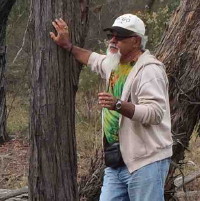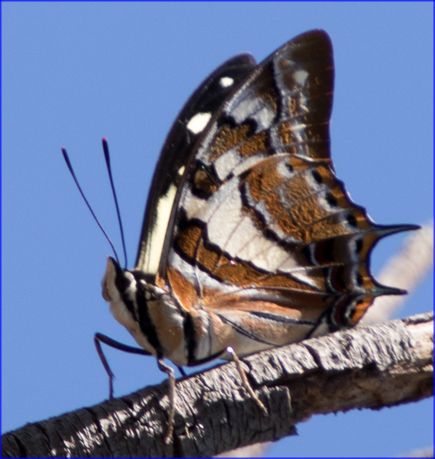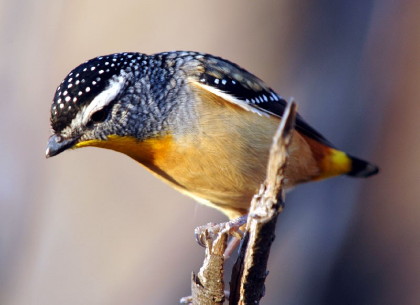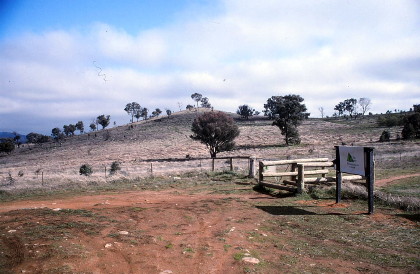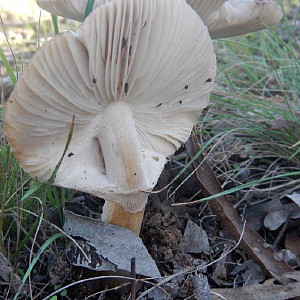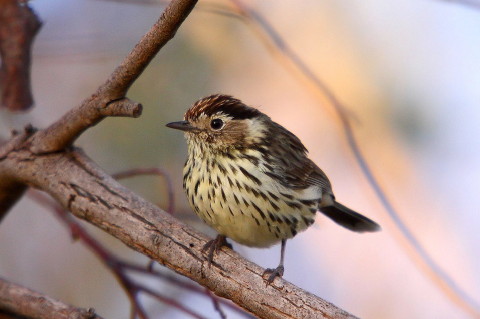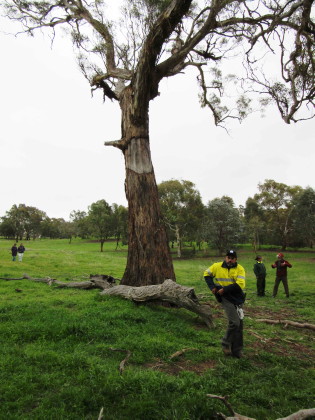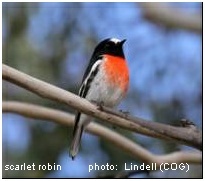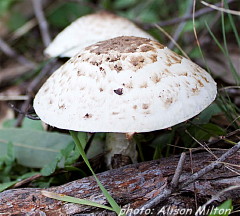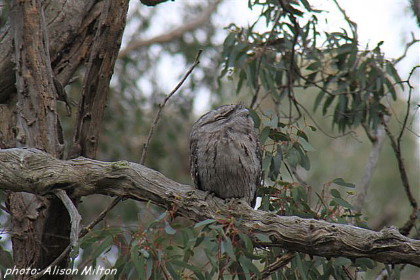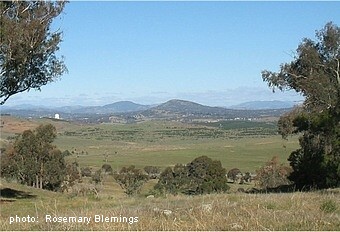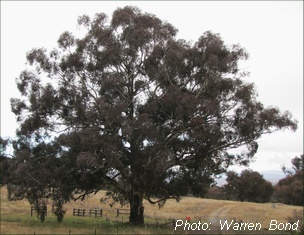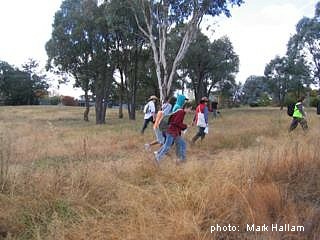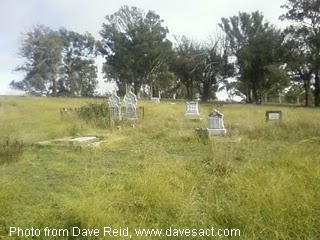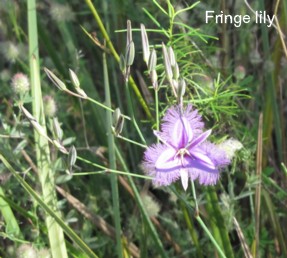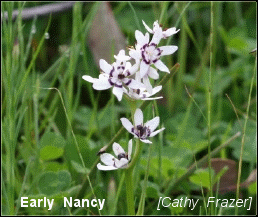  |
the walkers' blog personal accounts of walks on the pinnacle |
|
*This event is supported with funding made available by the ACT Government under the ACT Heritage Grants Program. John Brannan Ngunawal elder Wally Bell led a highly successful Aboriginal Heritage walk at the Pinnacle Nature Reserve on Sunday April 22nd. Almost thirty people turned up to hear Wally talk about the connection that his family and his people have to the land that we now call Canberra. He discussed Ngunawal cultural practices, passing around artifacts to illustrate his talk, and gave a welcome to country in language, something that I think made a deep impression on everyone present.
Elizabeth Smith, Rosemary Blemings, Alison Milton The first Pinnacle Butterfly Walk took place on a very pleasant, clear and sunny, late summer morning, ideal for butterflies as the temperature was between 20 and 33 degrees. The broad sweep of the Brindabella Ranges and Molonglo Gorge landscapes were a constantly beautiful backdrop to our walk. Flight styles from butterfly and bird species remind us that, like humans’ movements, identification is possible from observing how animals move.
Elizabeth Smith John Brannan guided another very enjoyable bird-walk at the Pinnacle on 19 April. The morning was pleasantly cool with alternating sun and light cloud, ideal for bird-watching. By the time we finished the walk, very dark clouds and curtains of rain were gathering over the mountains and we managed to leave about 5 minutes before the heavens opened.
Warren Bond It was a perfect, calm, sunny late-autumn morning on 17 May for our 4 km walk around the western end of The Pinnacle Nature Reserve. The walk was built around the opportunity to visit locations where we had photographs taken some years ago (such as the view of the Pinnacle from the Springvale Track shown to the right) and compare them with current views. Other stops were included along the way where we could view and/or discuss progress with weed control, revegetation and remaining conservation challenges on the Reserve.
Elizabeth Smith John Brannan guided another very enjoyable bird-walk at the Pinnacle on 19 April. The morning was pleasantly cool with alternating sun and light cloud, ideal for bird-watching. By the time we finished the walk, very dark clouds and curtains of rain were gathering over the mountains and we managed to leave about 5 minutes before the heavens opened.
Alison Milton Autumn in Canberra in 2014 was surprisingly mild with clear, calm, warm days. The conditions were ideal for sprouting fungi and I made several forays into the Reserve in search of specimens. I was not disappointed, though the species I'd seen a year or two ago were not in evidence.
John Brannan and Alison Milton In April 2014, John led a guided bird walk with the hope of spotting some of the migratory birds that move through the Reserve every Autumn. It was a delightful stroll with many familiar faces and quite a few new ones. It included members of fotpin, the Field Naturalists and members of the public drawn in by it being widely advertised.
Elizabeth Smith On a cold and grey autumn morning, Wally and Tyronne Bell guided 48 people (a record number for fotpin) on a fascinating walk through the top end of the Pinnacle Nature Reserve, identifying and explaining specific aspects of aboriginal use of environmental resources. They also gave an insight into the traditional history of the Ngunawal area and the cultural use of the region. Wally and Tyronne Bell are the eldest and youngest sons of Don Bell, the well known and highly respected Ngunawal elder. They have both worked in various ways over many years to support, protect and explain the indigenous heritage and culture in the Ngunawal area. They are from Yass, and are of the Yarr people, part of the Ngunawal cultural group.
Craig Wainwright Forty years of memories are tied up in this landscape for me; but what of its pre 1970s past and what of its future when I am gone? What did it look like, what shaped its present appearance and what will it look like? What legacies exist and what is our legacy? These thoughts led me to the theme 'The Changing Landscape' for my interpretive walk on 4 May 2014. To inform my presentation I drew on a wide range of resources – archival photos and articles, books, conversations with older inhabitants of the area and their resources , as well as references and ideas from other friends and colleagues.
Elizabeth Smith One thing about The Pinnacle Nature Reserve is that you never know what you might come across. When you visit the Pinnacle, take time absorb its many delights.
Rosemary Blemings After over 100 mm of rain in the last 3 weeks, 30 mm of it yesterday, the Pinnacle Nature Reserve’s southern boundary track serves as a geomorphology site. Run-off along the poorly vegetated space has gouged descriptive patterns as it erodes the substrate and created new deposits of soil particles. In just a few weeks following the rain and the mild weather, the diversity of fungi of all shapes and colouring is staggering.
Rosemary Blemings Before we moved off from the Dungowan St entrance, we watched, entranced as a Willie wagtail chased and caught a butterfly in mid-air. Aerial ballet. It took off the hapless insect’s wings before taking the body to its nestlings in a tiny cobwebby nest that’s visible from the cavaletti. This display explained the collection of butterfly wings by the cavaletti’s logs last year. Eucalyptus rossii crossed with E. melliodora is the verdict of Peter Ormay in relation to the magnificent ‘Dungowan’ Eucalypt that currently hosts nesting pairs of Rainbow lorikeets, Magpie-larks, Willie wagtails and the now-fledged Tawny Frogmouths.
Rosemary Blemings Birds have been an inspiration, passion and study for John Brannan for many years. His interpretations and knowledge of this year’s nesting behaviour and avian presences allowed the morning walk to morph into a real learning experience for all of us. Choughs are nesting deep in the Stringybark forest. They’ve refurbished their large, cup-shaped mud nest to accommodate this year’s chicks. The 7-8-strong colony of birds will raise the young communally. Cryptandra amara with its white, fragrant, bell-shaped flowers brought almost-bridal effects to the low-growing shrubs.
Rosemary Blemings Entering the reserve from near the de Salis St carpark and heading east, we noted that weeds were more prevalent beside the various tracks ... unsurprising given the constant passage of vehicles (and their slip-streams), feet and paws. Beside and approaching the mobile phone tower building there's a mix of introduced and native grasses. fotpin weeders have worked hard here taking out African Lovegrass tussocks mostly by spraying. There were several dense patches of Weeping grass Microlaena stipoides though they looked a bit "wintry" after late-summer flowering. Red grass was there also spread more individually beside the access track. Pigeon grass was pointed out as its emergence as a potential problem grass seems quite recent in The Pinnacle NR.
Rosemary Blemings As the six of us assembled near the Dungowan eucalypt we looked into the adjacent Kama paddock and pondered whether the massive Yucca-Aloe Vera-like plants and the yellow-leaved deciduous trees were evidence of some sort of homestead or residence in times past. Today’s roads and fences are deceptive and make it difficult to imagine any other ‘carving-up’ of the land or to compare any old maps to establish where the Weetangera settlers’ original dwellings were. We also pondered the identification of the eucalypt, again! This led us towards explaining what a ‘key’ is in this context. With a small twig, branch or leafed flower stem in hand botanists follow a series of multiple choice questions to take them closer to the species’ name by a process of elimination. John and Lesley have worked on the Dungowan eucalypt but, like others, have not come to a definite conclusion. The original Pinnacle brochure calls it a Red box Eucalyptus polyanthemos but knowledgeable folk seem to be united in rejecting that! Perhaps it’s a hybrid.
Rosemary Blemings Congratulations to those who chose to be outdoors on a perfect Autumn day counting kangaroos! I reckon our ages ranged from seven to seventy and our backgrounds were just as diverse. There’s no danger of our suffering from Nature Deficit Disorder (NDD) as we worked our way through a variety of habitats, touched plants and made footsteps on soil and vegetation in every stage of life. There was no time this Mayday to reflect on why the Pinnacle Nature Reserve means so much to us but those reasons surrounded us as we walked through the reserve. The air’s freshness, endless sky, bird movements and calls, greenery’s textures, trees rejuvenated by the good seasons and, ever-inspirational, the stunning Brindabella ranges as backdrop to our endeavours. The morning’s clear skies gave way to whispy overhead clouds and cumulus on the horizon … massive edifices of vapour ever-changing in form, colour and brightness.
Rosemary Blemings With unannounced gales beginning before dawn, the 16th wasn't a day to be walking amongst the reserve's trees. Instead we walked west from Dungowan Street towards Weetangera Cemetery. There's a broad swathe of grass between the paddocks and the large gardens of Hawker's westernmost streets. The mowing regime seems back on-track and the householders have magnificent views into the lower Molonglo valley and towards the Brindabella Range.
Rosemary Blemings We were delighted to welcome Maureen and Rosella to their first Guided Walk. The Pinnacle isn't strange territory to either of them and, as always happens, all walkers make contributions to our knowledge and observations along the way. Expecting a hot day, we left Dungowan Street and then followed the southern track in the partial shade of the Stringybark forest. Some 100 m after the junction with the track through the forest we donned gaiters and explored the North Kama paddock's most westerly rocky knoll. Moving north and then west brought us into the forest to explore the changes since December.
Rosemary Blemings Seven of us gathered at Dungowan Street under the occasionally-watchful eye of the male Frogmouth. We followed the fairly-standard route moving up behind the Hawker houses and stepping-through into the northern edge of the Stringybark forest. Then we wound down the main track with quite frequent deviations before reaching the southern perimeter track with its views over the Molonglo Valley. Our last 100 metres set a rapid pace as the storm broke.
Third-Saturday Guided Walk, 20 Nov 2010 Rosemary Blemings Once we'd had a look at the swathe of Common sunray (Triptilodiscus pygmaeus) on the edge of, and unexpectedly in, the paddock east of Dungowan Street the fate of the walk was sealed ... we became obsessed with plants. However we did see or hear at least 29 species of birds (30 if you count the Bowerbird I'd seen in a Marrakai Street garden the day before).
Third-Saturday Guided Walk, 18 Sep 2010 Rosemary Blemings A bland title for a very enjoyable walk shared by six of us, which brought together knowledge, curiosity, observations and gratitude for the beginnings of spring in a local 'park'. I started to write an account of the walk straight afterwards but it didn't 'gel'. On Sunday I returned to the spot where we found a mystery blue 'pea-flower' and took what I hope are better photographs. As I climbed through the fence afterwards I came across a couple walking along the track after being in the reserve. I asked them if they'd seen any orchids. They were a bit nonplussed so I offered to show them those we'd seen. Back through the fence, a wander around and they were impressed by our 'rocky garden'.
|
© Friends of The Pinnacle
